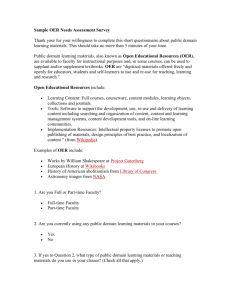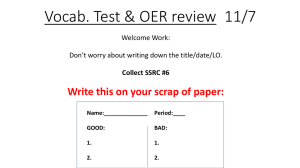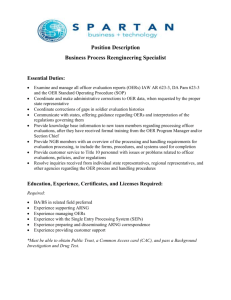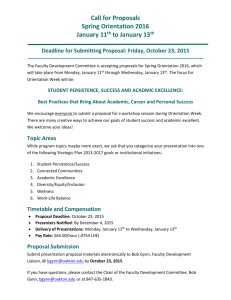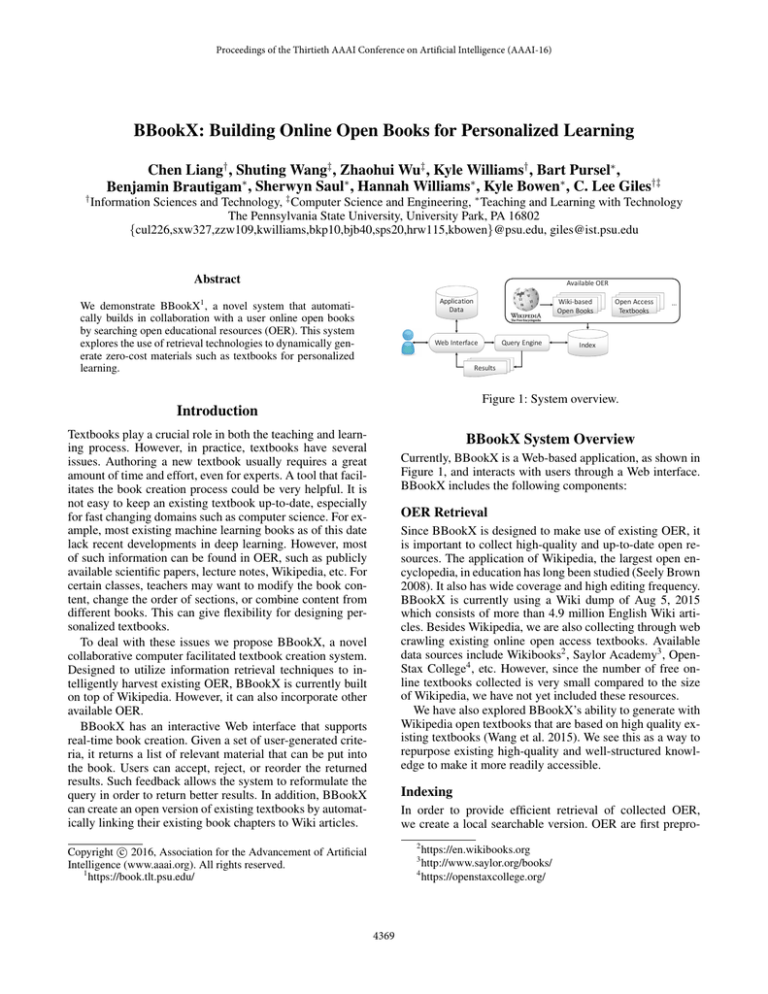
Proceedings of the Thirtieth AAAI Conference on Artificial Intelligence (AAAI-16)
BBookX: Building Online Open Books for Personalized Learning
†
Chen Liang† , Shuting Wang‡ , Zhaohui Wu‡ , Kyle Williams† , Bart Pursel∗ ,
Benjamin Brautigam∗ , Sherwyn Saul∗ , Hannah Williams∗ , Kyle Bowen∗ , C. Lee Giles†‡
Information Sciences and Technology, ‡ Computer Science and Engineering, ∗ Teaching and Learning with Technology
The Pennsylvania State University, University Park, PA 16802
{cul226,sxw327,zzw109,kwilliams,bkp10,bjb40,sps20,hrw115,kbowen}@psu.edu, giles@ist.psu.edu
Abstract
We demonstrate BBookX1 , a novel system that automatically builds in collaboration with a user online open books
by searching open educational resources (OER). This system
explores the use of retrieval technologies to dynamically generate zero-cost materials such as textbooks for personalized
learning.
!
Figure 1: System overview.
Introduction
Textbooks play a crucial role in both the teaching and learning process. However, in practice, textbooks have several
issues. Authoring a new textbook usually requires a great
amount of time and effort, even for experts. A tool that facilitates the book creation process could be very helpful. It is
not easy to keep an existing textbook up-to-date, especially
for fast changing domains such as computer science. For example, most existing machine learning books as of this date
lack recent developments in deep learning. However, most
of such information can be found in OER, such as publicly
available scientific papers, lecture notes, Wikipedia, etc. For
certain classes, teachers may want to modify the book content, change the order of sections, or combine content from
different books. This can give flexibility for designing personalized textbooks.
To deal with these issues we propose BBookX, a novel
collaborative computer facilitated textbook creation system.
Designed to utilize information retrieval techniques to intelligently harvest existing OER, BBookX is currently built
on top of Wikipedia. However, it can also incorporate other
available OER.
BBookX has an interactive Web interface that supports
real-time book creation. Given a set of user-generated criteria, it returns a list of relevant material that can be put into
the book. Users can accept, reject, or reorder the returned
results. Such feedback allows the system to reformulate the
query in order to return better results. In addition, BBookX
can create an open version of existing textbooks by automatically linking their existing book chapters to Wiki articles.
BBookX System Overview
Currently, BBookX is a Web-based application, as shown in
Figure 1, and interacts with users through a Web interface.
BBookX includes the following components:
OER Retrieval
Since BBookX is designed to make use of existing OER, it
is important to collect high-quality and up-to-date open resources. The application of Wikipedia, the largest open encyclopedia, in education has long been studied (Seely Brown
2008). It also has wide coverage and high editing frequency.
BBookX is currently using a Wiki dump of Aug 5, 2015
which consists of more than 4.9 million English Wiki articles. Besides Wikipedia, we are also collecting through web
crawling existing online open access textbooks. Available
data sources include Wikibooks2 , Saylor Academy3 , OpenStax College4 , etc. However, since the number of free online textbooks collected is very small compared to the size
of Wikipedia, we have not yet included these resources.
We have also explored BBookX’s ability to generate with
Wikipedia open textbooks that are based on high quality existing textbooks (Wang et al. 2015). We see this as a way to
repurpose existing high-quality and well-structured knowledge to make it more readily accessible.
Indexing
In order to provide efficient retrieval of collected OER,
we create a local searchable version. OER are first prepro2
c 2016, Association for the Advancement of Artificial
Copyright Intelligence (www.aaai.org). All rights reserved.
1
https://book.tlt.psu.edu/
https://en.wikibooks.org
http://www.saylor.org/books/
4
https://openstaxcollege.org/
3
4369
(a) Building a book.
interface to add a chapter. After creating a chapter title and
adding a short description which can be keyphrases or sentences, users click the “Run” button to let BBookX retrieve
a list of relevant OER. When the system finishes searching,
users can review each result by clicking the links that allow
a preview in a new browser tab. Users then click the results
they wish to keep and add them to the “Saved Results” list.
If users are still not satisfied with the results or want more
relevant OER, they can click “Regenerate Results” to re-run
the search. User feedback is be utilized by the system to reformulate the query for other results. In addition, BBookX
supports reordering OER or chapters by dragging and dropping. The built books can be exported as text files for further
editing or as HTML for embedding in other Web pages.
(b) Adding a chapter.
Figure 2: Web interface.
Existing Systems
To our knowledge, other existing textbook building systems
do not support the automatic retrieval and organization of
OER, but require manually attached related resources. For
example, Wikibooks offers a wiki-based platform allowing
users to create books collaboratively. FlexBook6 is a textbook authoring platform where users produce and customize
the book content by re-purposing educational content.
cessed, which includes tokenization, stop word and punctuation removal, conversion to lower case, and stemming.
Apache Solr5 builds a full text index for the content of each
document. In this phase we also extract the keyphrases of
each document using the Maui tool (Medelyan, Frank, and
Witten 2009) and index them to compute a similarity score.
Querying
Conclusions and Future Work
Given the user-specified description q about a chapter,
BBookX will first query q in the pre-built index and return a
set of candidate relevant OER. For each candidate resource
d, BBookX calculates the similarity score between q and d
based on a weighted combination of title similarity, content
similarity, and keyphrase similarity. Then a ranked list of
relevant OER is returned to users.
So users can modify the results, BBookX allows them to
decide whether to accept or reject any returned resource. A
relevance feedback mechanism is incorporated in the system
to reformulate the query based on users’ judgements about
returned results. Specifically, the top 20 keyphrases from resources kept by users are selected based on term frequency
and used for query expansion. These keyphrases are added to
q to form a new query q . Users’ feedback is especially helpful when the query includes words that have multiple senses,
such as “apple”, “set”, etc. More details of the BBookX’s
backend can be found in (Liang et al. 2015a).
We introduced BBookX, a novel collaborative automatic
text book building system designed that makes use of available open educational resources and applies simple but useful information retrieval methods that facilitate a textbook
authoring process. Currently we are working on incorporating prerequisite relations among concepts (Liang et al.
2015b) into BBookX, which aims to increase the coherence
of the book.
Acknowledgments
We gratefully acknowledge partial support from the National Science Foundation.
References
Liang, C.; Wang, S.; Wu, Z.; Williams, K.; Pursel, B.; Brautigam,
B.; Saul, S.; Williams, H.; Bowen, K.; and Giles, C. L. 2015a.
Bbookx: An automatic book creation framework. In Proceedings
of DocEng, 121–124. ACM.
Liang, C.; Wu, Z.; Huang, W.; and Giles, C. L. 2015b. Measuring
prerequisite relations among concepts. In Proceedings of EMNLP,
1668–1674. ACL.
Medelyan, O.; Frank, E.; and Witten, I. H. 2009. Humancompetitive tagging using automatic keyphrase extraction. In Proceedings of EMNLP, 1318–1327. ACL.
Seely Brown, J. 2008. Open education, the long tail, and learning
2.0. Educause review 43(1):16–20.
Wang, S.; Liang, C.; Wu, Z.; Williams, K.; Pursel, B.; Brautigam,
B.; Saul, S.; Williams, H.; Bowen, K.; and Giles, C. L. 2015. Concept hierarchy extraction from textbooks. In Proceedings of DocEng, 147–156. ACM.
Web Interface
The software for BBookX is a node application built with
the SANE stack (Sailsjs and Emberjs). Sailsjs is used for
the API interface to store in MongoDB the application data,
including information about users and their built books. Emberjs is used to build the JavaScript front end.
The current web interface components are shown in Figure 2. To use BBookX, users start with registration and login. They can then choose to keep working on previously
built books in the “Library” or start building a new book.
The book building process first requires adding a book title.
As shown in figure 2a, users can then click the “Add Chapter” button to work on a new chapter. Figure 2b shows the
5
6
http://lucene.apache.org/solr/
4370
http://www.ck12.org/

